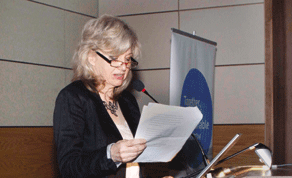The Qatar Green Building Council (QGBC) has hosted a conference on “Women and the Sustainable Built Environment: Qatar Prospects” to mark International Women’s Day at Qatar Foundation Student Centre in Education City.

Kathryn Findlay addressing the event
Qatar University, the National Association of Women in Construction-Qatar (NAWIC) and the Royal Institute of British Architects-Gulf Chapter (RIBA) were partners in organising the event.
NAWIC-Qatar chair Melanie Robson, who opened the event, introduced internationally renowned architect Kathryn Findlay, who is currently designing the Doha Art Foundation and official residence for the Minister of Culture, Arts and Heritage, Qatar.
Responsible for iconic designs such as the ‘Soft and Hairy House’ and the ‘Truss Wall House,’ Findlay has created waves though her organic architectural aesthetic.
Addressing the audience that comprised a balanced mix of students and established engineers, she spoke about her personal architectural philosophy and the beginnings of her design agency Ushida Findlay, which has a long standing relationship with Qatar.
“As with all of our buildings, context influences our design. We’re interested in the indigenous craft, climate and culture of our projects. The result is an architectural language that expresses buildings and spaces as natural elements, which has earned our style the name ‘Future-rustic,” she said.
Holley Chant, director, corporate sustainability, KEO International Consultants, spoke about the opportunities awaiting women for leadership and excellence in the sustainability space in Qatar.
Environmentally sustainable tourism in Qatar was the table-topic led by Dr Rania Khalil (assistant professor of Architecture and Urbanism in the Department of Architecture and Urban Planning, Qatar University) with her senior students.
Her academic experience and teaching activities include lecture courses in planning theory, housing policies, urban conservation, urban design, and urban planning legislation.
Paula Boast, vice-chair of the National Association of Women in Construction (UK), elaborated on adapting construction contracts to build a sustainable Qatar, based on her experience with FIDI (French for the International Federation of Consulting Engineers).
Extending her relationship with QGBC, following the launch of the green infrastructure interest group earlier this year, Dr Anna Grichting (assistant professor in the Department of Architecture and Urban Planning at the College of Engineering, Qatar University) discussed ways to improve the quality of the urban environment.
Doha-based South African architect Ana Maria Nomico shed light on ecological architecture.
The event was closed by Professor Ashraf M Salama, professor of architecture and founding head of the Department of Architecture and Urban Planning at Qatar University and Royal Society of the Arts-FRSA, UK.
He called on his students to build careers in engineering and commended the efforts of the high-profile speakers in inspiring such a change in Qatar where a steady increase in the percentage of women studying architecture and engineering is already being witnessed.
Mohamed Jaber, head of education committee at QGBC, described the conference as a landmark event in influencing notions of how women engineers are perceived in the region.



